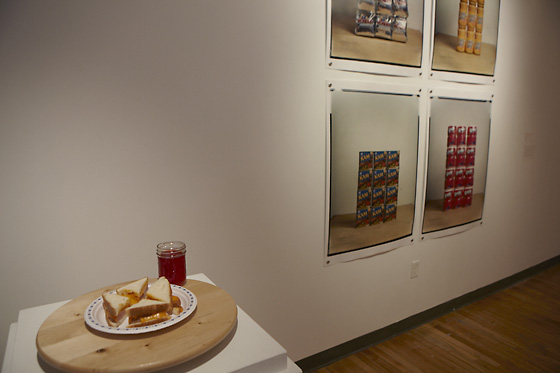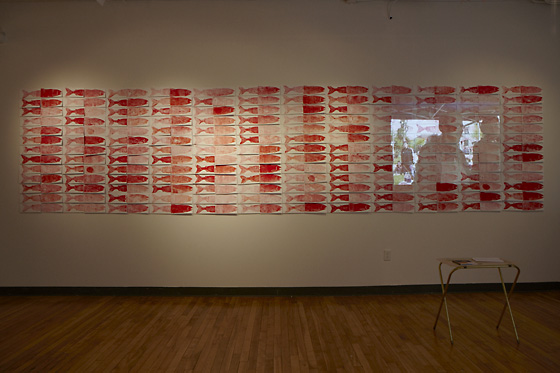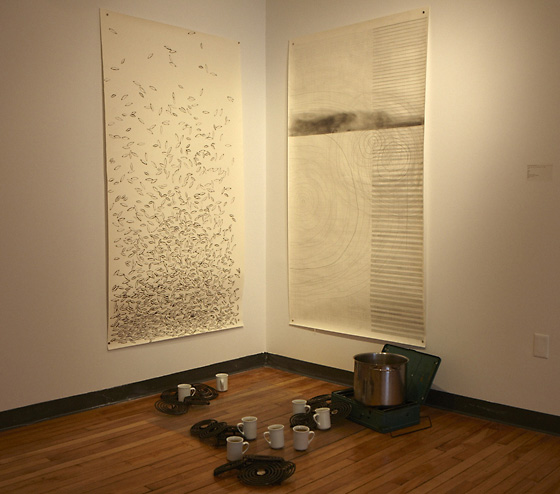
KC Adams, The Gift That Keeps on Giving (2011). Clay pots, river rocks, white flour, white sugar, salt, milk and lard. Photo: KC Adams.
Artists and theorists often formulate opinions of art world hierarchies according to Jenny Holzer's common sense maxim, THE ABUSE OF POWER COMES AS NO SURPRISE. Every curator, even the most community-minded, has to figure out how to manage power dynamics in relationship to artists and artworks. Specifically, I am thinking about the common complaint artists have that curators manipulate and re-contextualize their work in order to illustrate a curatorial agenda. In the worst case scenarios, artists are positioned as inarticulate makers and curators as the ones who illuminate the meanings of the works in cultural context. But there are many curators for whom the politics of representation are deeply embedded in their practice. In order to take a closer look at the processes of curation, I will present discussions with two curators who have inspired me with their approach to power. Next month I will talk with Patrick Macaulay, Head of Visual Art at Harbourfront Centre in Toronto. This month, I talk with the Toronto based emerging curator Lisa Myers.
Having just finished her Masters of Fine Art in Criticism and Curatorial Practice at OCADU, Lisa Myers is already garnering quite a bit of attention in the Canadian art world. In 2010 she collaborated with fellow student and curator Suzanne Morrissette on the exhibition past now, a show with two emerging Aboriginal artists—Meryl McMaster and Luke Parnell. Each artist embodies past historical motifs in living contemporary forms. The exhibition was first mounted at the OCADU Graduate Gallery in March of 2010, and then expanded into a large-scale installation at the MacLaren Art Centre in Barrie that ran from November 2010 into February 2011.
Lisa's very recent thesis exhibition, Best Before, was an ambitious project featuring funny and poignant installations about the encoding of food from Aboriginal perspectives. The artists — KC Adams, Keesic Douglas, Cheryl L'Hirondelle, Peter Morin and Suzanne Morrissette — have diverse practices, and come from very different points in their careers, some just now emerging and some with international profiles already established. The works resonated very well in dialogue with one another, creating a reflective aesthetic space with a strong emotional charge.
Sally: You've mentioned that collaboration is a big part of your process. Can you talk about some of the specific ways that collaboration has manifested in your practice?
Lisa: I can relate collaboration to my experience as a chef running kitchens where everyone has something to contribute and even though I was running the show I couldn't do it without the team. Similarly, to me curators and artists have an interdependent relationship that calls for careful consideration.
I use the term collaborate to describe my approach to my thesis exhibition Best Before mostly to explain that the artists and I examined the curatorial thesis together. Especially with this project, collaboration made sense since I invited the artists to make work that responded to a recipe of their choice (in some cases the recipe emerged after the work). The responsibility of representing artists through curatorial writing and exhibitions is daunting and I negotiate it carefully and with respect. I check in with the artists and consider their input integral. My collaborative practice includes talking through ideas with the artists, whether they concern the developing of artworks or the exhibition design and use of space. I also share my writing with the artists during the early stages of developing the exhibition which gives us a chance to respond to one another, and builds trust.

Keesic Douglas, 4 Reservation Food Groups (2010). Four chromagenic prints, Cheez Whiz, Kam, Wonderbread, Kool-Aid, water, audio file of Mark Douglas telling his Kam story. Photo: Keesic Douglas.
S: I want to ask about how you deal with power. Issues of representation are particularly charged when working with Aboriginal artists. As a curator, how do you come to terms with your own role as a gatekeeper?
L: I don't think of what I do as gate keeping but yes I have the power to choose artists for the exhibitions that I curate. At the same time I'm also cognizant of the fact that the aritsts have power too, without artists and artworks there's no show.
Gate keeping makes me think of the way historically Indigenous people were represented in museums as “primitive,” extinct and “people of the past”. In my opinion, works like James Luna's Artifact Piece marked an important flash point in 1987, as he laid in a vitrine at the Museum of Man in San Diego. As a living and breathing person, Luna took up the position of the artifact and in doing so, his performance raised questions about power. Specifically, I think Luna's work prodded at the power of museums to display and portray indigenous cultures as static and only existing in the past. This performance underlined the power of the art world. Work by Indigenous artists pushed boundaries between what was deemed suitable to be displayed in museums as cultural artifacts and what was to be exhibited in museums or galleries as Art. I also consider the curatorial projects by Lee Ann Martin, Gerald McMaster and Richard William Hill, just to name a few of the significant number of Indigenous curators who have worked for decades to tease out artworld hierarchies.
Despite my internal conflict about power and the responsibility of representation, I still have to own some authority and part of the responsibility of representing involves acknowledging and owning the authority or power.
S: I'm wondering if you feel like you have been taking curatorial risks. In my interpretation, past now was a very edgy show. Both Luke Parnell and Meryl McMaster put very finely nuanced spins on imagery that could be described as “traditional” in the historical context of Aboriginal art and craft. Some really high profile Aboriginal artists — I'm thinking specifically of Kent Monkman, Brian Jungen and Terrance Houle — make overt, ironic use of traditional tropes in order to subvert them through inversion. Parnell and McMaster are critically astute artists, but they both go for a high impact, visual aesthetic that seems to fall on the side of embracing traditional practices rather than poking fun at them. I'm wondering if you agree with this interpretation, and whether or not putting these works together felt at all risky for you and Suzanne in the context of contemporary Aboriginal art practice?
L: Monkman, Jungen and Houle in some cases use parody and I think that their work also investigates sophisticated visual languages that haven't been included in the critical art discourse. For example, in one of Jungen's works where he creates customary beading designs by drilling holes into jerry gas cans, the result is often seen as a post modern mash up of sorts. But I'm also interested in the potential for critical art writing from an Indigenous perspective to address the specific symbolism encoded in such beading designs. In a lot of cases, the best writing about Aboriginal or Indigenous art is happening now in our exhibition catalogues. This speaks to the importance of contemporary art and curatorial practice as informing written art history.
As for past now the biggest risk was that people wouldn't get it and they'd see it as fulfilling preconceived notions of what Native art looks like. But I think that the work successfully disrupted that and it's interesting to think about how, for example, Luke Parnell's carving evokes certain romantic ideas and iconography of the past and then slaps down some issues with big stakes. His installation 48 — comprised of 48 basswood carvings individually encased in acrylic boxes — responds to the repatriation by the Haida of human remains of their ancestors.
When I first saw Luke and Meryl's artwork I knew they would work in dialogue together and something really great would happen. Putting together past now was an intuitive moment. Luke's work takes customary design and images into a realm of examination of history and at the same time responds to pop culture and serious issues like repatriation of human remains. Meryl appropriates old Edward S. Curtis and Will Soule photographs to reflect on her own identity and ancestral connections. She expressed that it was important to her that everyone could relate to her photos and consider their own ancestors. The artwork really led the exhibition premise.
S: Following on from the last question, I know from previous discussions that you received some strong emotional feedback from audiences at your thesis exhibition Best Before. On one hand, many of the works could be interpreted as light and playful, but it seems as if, for some people, a quite tragic and painful subtext was also emerging through the humour. Do you embrace the dark side, or are some issues just too sensitive to take on directly?
L: The artists were responding to recipes of their choice and the emotional response was a result of the exhibition's premise. Colonization involved displacement from land and shifts in food sources, commodity foods were introduced in manners that some would consider acts of violence, so it wasn't unexpected that the work would deal with difficult subject matter. One of the long-term effects of this colonial history involves the rates of type two diabetes being three to five times higher in Aboriginal communities than those of the rest of the population across Canada. I wasn't doing the show to be merely provocative, it was inspired by performance work by James Luna and Lori Blondeau, which I linked to my experience as a cook and the health issues in my own community and family around diabetes and cancer. These difficult topics are as important as the humour that some of the work evokes. I think the playfulness comes hand in hand with what you call the dark side. For some the show was about the deleterious effect of processed food, for others it was the potential of any food to be incorporated as a family food tradition and many other ideas were all at play.

Peter Morin, Salmon and Bannock (2005/2010). Letter envelopes, hand-printed lino prints and video documentation of Team Diversity: World's Largest Bannock Attempt (2005) Photo: Keesic Douglas
S: I really appreciate the fact that all of the artists in Best Before are given equal weight in the exhibition, despite the fact that some have a really high profile while others do not. Was this an accident of how this particular show came together, or is it indicative of a curatorial agenda to work against the grain of hierarchical artworld structures?
L: Giving each artist equal weight in the exhibition seemed the most respectful way to work with the artists, and visually it gave the exhibition a certain balance in the space. It wasn't entirely conscious but in the end I learned a lot and I would attribute it to working with artists at different stages in their career. This was the range of artists I found that incorporated food in their practice.
I think this relates to the audience too, this show was successful in engaging a non-art audience just because the ubiquitous nature of food engages people without being intimidating. I think the subject of food as an art medium, or a researchable topic with the discourse of art history, itself challenges the hierarchical structures of the art world.

Suzanne Morrissette, solve for spur to bum area, for some (2011). Paper, pencil, pen, ink, metal screen, electric stove elements, camping stove, stock pot, and Labrador Tea. Photo: Keesic Douglas.
S: You are an artist as well as a curator. I'm wondering if you feel like having an art practice impacts your curatorial process in negative and/or positive ways. It is important to listen to the artworks first and foremost and respect the artists, as it is sometimes difficult not to get carried away and deploy artworks as points of argument toward a curatorial proposition. How do you negotiate these kinds of tensions in your practice?
L: You raise some important points here. As an artist I know how art drives ideas, in terms of curatorial work I see it as another creative process that puts works into conversation together — in this conversation something new happens and it's the art together that makes it happen. I don't want to force that, and I like how sometimes unexpected things happen once the show is installed. I'm sure that work gets recontextualized all the time. I may do that too, but not because I think it lacks some articulation on the artist's part. I think that a perceived manipulation takes place because there's a lack of communication and dialogue between the artist and curator. I also think that it's nearly impossible to represent an artwork like the artist would. I appreciate when artists and artists' collectives put together shows without curators.
Lisa Myers is a curator, artist and musician. Her MFA research in Criticism and Curatorial Practice at OCAD University investigated cultural agency and the encoding of food from diverse Indigenous perspectives, and resulted in the exhibition titled Best Before. This summer Myers will be working on numerous projects including artwork for a forthcoming exhibition, a series of performances with the band Adaptor 45, and planning a curatorial collaboration with artist Rebecca Diederichs. This August, Myers will present at the 6th International Conference of Critical Geography in Frankfurt, Germany. Lisa Myers lives and works between Toronto and Port Severn, Ontario.




Comments on this entry are closed.
{ 1 trackback }